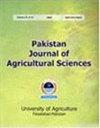Biochemical base of resistance in citrus against canker disease
IF 0.6
4区 农林科学
Q3 AGRICULTURE, MULTIDISCIPLINARY
引用次数: 1
Abstract
Biochemical compounds are important factors in plant-disease interactions. Plants become prone to pathogen infection due to alterations in these compounds which help the plants in restricting the pathogens. Knowledge of these alterations is helpful for researchers to develop some concrete solutions for the management of canker disease. For this purpose, experiments were conducted with three replications to find out the alterations in biochemical compounds of citrus leaves infected with canker disease by artificial inoculation through syringe method. So, six varieties (three susceptible and three resistant) were selected after two years screening of thirty species of citrus under natural field conditions. Leaves of susceptible (Grapefruit, Succari, Kinnow) and resistant (Kumquat, Jaffa, China lemon) varieties of inoculated and un-inoculated groups were collected and analyzed for variation in biochemical compounds by using Nested Structured Design. Variations (p ≤ 0.05) were observed in the biochemical compounds among the treatment types. Resistant type of plants expressed 3.35, 2.90, 1.01, 2.10, 2.50, 3.18, and 0.66 µg/g, susceptible type expressed 2.29, 2.49, 1.36, 2.41, 1.73, 4.13 and 0.86 µg/g of total phenolic contents, total soluble sugars, super oxidase dismutase, peroxidase, total soluble proteins, catalase and hydrogen peroxide respectively, while in case of groups, inoculated pants expressed 1.59,2.52, 1.98, 3.20, 0.93, 5.11 and 1.21 µg/g and un-inoculated group exhibited 4.05, 2.87, 0.39, 1.30,3.29, 2.19 and 0.30 µg/g. These variations can be used as biochemical markers to identify source of resistance in citrus species against canker disease.柑桔溃疡病抗性的生化基础
生化化合物是植物与疾病相互作用的重要因素。由于这些化合物的改变有助于植物限制病原体,植物变得容易感染病原体。了解这些变化有助于研究人员为溃疡病的管理制定一些具体的解决方案。为此,通过三次重复实验,通过注射器法人工接种感染溃疡病的柑橘叶片,了解其生化成分的变化。因此,在自然田间条件下,对30种柑桔进行了两年的筛选,选出了6个品种(3感3抗)。收集接种组和未接种组的感病品种(葡萄柚、琥珀、金诺)和抗性品种(金桔、雅法、柠檬)的叶片,采用嵌套结构设计分析其生化成分的变化。在不同处理类型之间观察到生化化合物的变化(p≤0.05)。抗性类型的植物分别表达3.35、2.90、1.01、2.10、2.50、3.18和0.66µg/g,感病类型的植物表达2.29、2.49、1.36、2.41、1.73、4.13和0.86µg/g总酚含量、总可溶性糖、超氧化酶歧化酶、过氧化物酶、总可溶性蛋白、过氧化氢酶和过氧化氢,而在群体中,接种的裤子表达1.59、2.52、1.98、3.20、0.93,5.11和1.21µg/g,未接种组分别为4.05、2.87、0.39、1.30、3.29、2.19和0.30µg/g。这些变异可以作为生物化学标记来鉴定柑橘品种对溃疡病的抗性来源。
本文章由计算机程序翻译,如有差异,请以英文原文为准。
求助全文
约1分钟内获得全文
求助全文
来源期刊

Pakistan Journal of Agricultural Sciences
AGRICULTURE, MULTIDISCIPLINARY-
CiteScore
1.80
自引率
25.00%
发文量
18
审稿时长
6-12 weeks
期刊介绍:
Pakistan Journal of Agricultural Sciences is published in English four times a year. The journal publishes original articles on all aspects of agriculture and allied fields.
 求助内容:
求助内容: 应助结果提醒方式:
应助结果提醒方式:


